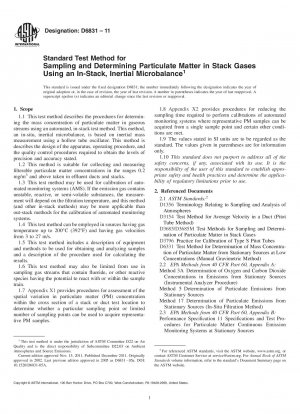ASTM D6831-11
Standard Test Method for Sampling and Determining Particulate Matter in Stack Gases Using an In-Stack, Inertial Microbalance
- Standard No.
- ASTM D6831-11
- Release Date
- 2011
- Published By
- American Society for Testing and Materials (ASTM)
- Status
- Replace By
- ASTM D6831-11(2018)
- Latest
- ASTM D6831-11(2018)
- Scope
The measurement of particulate matter is widely performed to characterize emissions from stationary sources in terms of total emission rates to the atmosphere for regulatory purposes.
This test method is particularly well suited for use in performance assessment and optimization of particulate matter control systems, continuous particulate matter emissions monitoring systems and the measurement of low concentration particulate matter laden gas streams in the range of 0.2 mg/m3 to 50 mg/m3.
1.1 This test method describes the procedures for determining the mass concentration of particulate matter in gaseous streams using an automated, in-stack test method. This method, an in-situ, inertial microbalance, is based on inertial mass measurement using a hollow tube oscillator. This method is describes the design of the apparatus, operating procedure, and the quality control procedures required to obtain the levels of precision and accuracy stated.
1.2 This method is suitable for collecting and measuring filterable particulate matter concentrations in the ranges 0.2 mg/m3 and above taken in effluent ducts and stacks.
1.3 This test method may be used for calibration of automated monitoring systems (AMS). If the emission gas contains unstable, reactive, or semi-volatile substances, the measurement will depend on the filtration temperature, and this method (and other in-stack methods) may be more applicable than out-stack methods for the calibration of automated monitoring systems.
1.4 This test method can be employed in sources having gas temperature up to 200C and having gas velocities from 3 to 27 m/s.
1.5 This test method includes a description of equipment and methods to be used for obtaining and analyzing samples and a description of the procedure used for calculating the results.
1.6 Stack temperatures limitation for this test method is approximately 200C (392F).
1.7 This test method may be also be limited from use in sampling gas streams that contain fluoride, or other reactive species having the potential to react with or within the sample train.
1.8 This standard does not purport to address all of the safety concerns, if any, associated with its use. It is the responsibility of the user of this standard to establish appropriate safety and health practices and determine the applicability of regulatory limitations prior to use.
ASTM D6831-11 Referenced Document
- ASTM D1356 Standard Terminology Relating to Sampling and Analysis of Atmospheres*, 2024-04-22 Update
- ASTM D3154 Standard Test Method for Average Velocity in a Duct (Pitot Tube Method)*, 2023-01-01 Update
- ASTM D3685/D3685M Standard Test Methods for Sampling and Determination of Particulate Matter in Stack Gases
- ASTM D3796 Standard Practice for Calibration of Type S Pitot Tubes
- ASTM D6331 Standard Test Method for Determination of Mass Concentration of Particulate Matter from Stationary Sources at Low Concentrations (Manual Gravimetric Method)
ASTM D6831-11 history
- 2018 ASTM D6831-11(2018) Standard Test Method for Sampling and Determining Particulate Matter in Stack Gases Using an In-Stack, Inertial Microbalance
- 2011 ASTM D6831-11 Standard Test Method for Sampling and Determining Particulate Matter in Stack Gases Using an In-Stack, Inertial Microbalance
- 2005 ASTM D6831-05a Standard Test Method for Sampling and Determining Particulate Matter in Stack Gases Using an In-Stack, Inertial Microbalance
- 2005 ASTM D6831-05 Standard Test Method for Sampling and Determining Particulate Matter in Stack Gases Using an In-Stack, Inertial Microbalance
- 2002 ASTM D6831-02 Standard Test Method for Sampling and Determining Particulate Matter in Stack Gases Using an In-Stack, Inertial Microbalance
